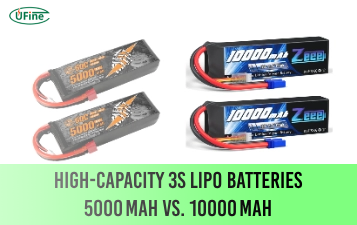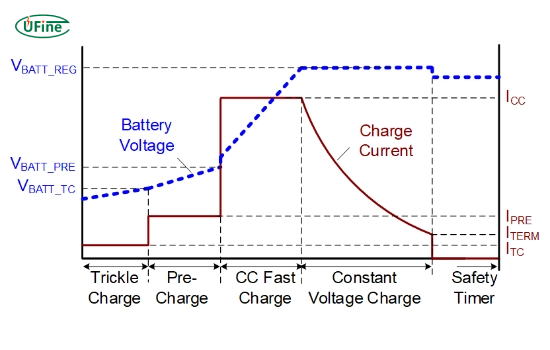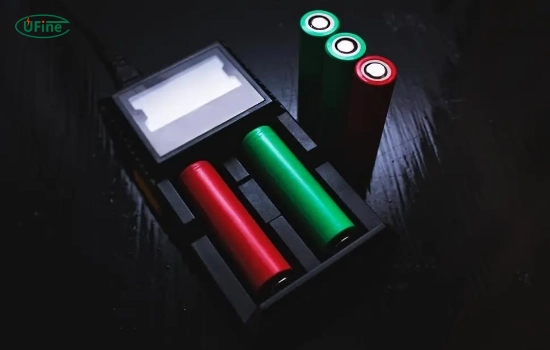How to Charge 18650 Battery? This comprehensive guide delves into efficient and safe charging methods, optimal charger selection, and strategies to maximize safety and longevity for your lithium-ion powerhouses. Explore fundamental principles for effective charging practices and unlock the full potential of your 18650 batteries.
Part 1. 18650 Battery charging principle
The charging principles of 18650 batteries are essential to maximizing performance and longevity. Lithium-ion technology uses a two-stage charging process: constant current and constant voltage. Let’s break down these key phases to ensure your 18650 battery lasts longer and performs better.
The Two-Stage Charging Process
- Constant Current Phase: During the initial charging phase, a constant current (usually 1C) is applied to charge the battery quickly and safely.
- Constant Voltage Phase: Once the battery reaches a set voltage (usually 4.2V), the charger switches to a constant voltage phase, maintaining this voltage and reducing the charging current.
Effective charging relies on avoiding overcharging, ensuring safe temperature levels, and using the right charger.
Part 2. 18650 Battery charging process
- 1. High Voltage Charging
High voltage charging begins with a voltage slightly above the battery’s nominal voltage (typically 4.2V for 18650 batteries). This approach accelerates the charging process in the initial phase, allowing for faster charging. However, careful monitoring is essential to avoid overcharging, which can lead to battery degradation or safety risks. A common approach is charging at 1C (1 times the battery’s capacity) until the voltage hits 4.2V and then gradually reducing the current to ensure safety.
- 2. Constant Voltage Charging
The charger switches to constant voltage mode once the battery reaches its full voltage limit (typically 4.2V). In this phase, the charger maintains 4.2V while decreasing the current progressively. This ensures safe charging, avoiding overcharge. After reaching 4.2V, the charger’s supply gradually tapers off to a low level.
- 3. Constant Current Charging
In constant current charging, a steady current is applied to the battery until it reaches the predetermined voltage (e.g., 4.2V). This method is ideal for faster charging but requires careful monitoring to avoid overcharging.
- 4. Smart Charging
Smart chargers use sophisticated algorithms and real-time data feedback to adjust the charging process based on factors such as battery temperature, voltage, and state of charge. For example, if a battery becomes too hot during charging, the charger will automatically reduce the charging current to ensure safe and efficient charging.
Fast charging vs. slow charging
Fast charging delivers a higher current to the battery, allowing for quicker replenishment of charge. For instance, a fast charger might deliver a current higher than 1C, enabling faster charge times. However, this can generate more heat, impacting long-term battery health. In contrast, slow charging involves lower currents, reducing heat generation and stress on the battery, which can prolong its lifespan. Balancing between fast and slow charging depends on the user’s priorities – speed or battery longevity.
Part 3. How to choose the 18650 battery charger?
Selecting the right charger for your 18650 batteries involves considering various factors to ensure optimal performance and safety:
- 1. Compatibility with Battery Types
Ensure the charger is compatible with different 18650 battery chemistries (e.g., lithium-ion, NiMH, NiCd). For instance, the Efest LUC Blu6 charger accommodates various 18650 types, including IMR and ICR lithium-ion batteries, making it suitable for various applications.
- 2. Charging Speed and Current
If you prefer faster charging, look for chargers that offer higher current ratings. For instance, the XTAR VC4S charger supports up to 3A per slot, ideal for high-drain applications like power tools or vaping devices. Charging at higher currents reduces charging time but may increase heat generation, so it’s essential to ensure proper heat management.
- 3. Safety Features
Look for chargers with advanced safety features like overcharge protection, reverse polarity detection, and temperature sensors. Chargers such as the Nitecore SC2 integrate these features to ensure your 18650 batteries are charged safely, reducing the risk of accidents.
- 4. Portability and Convenience
If you’re always on the go, opt for compact chargers like the Xtar MC1 Plus that can easily fit into a bag or pocket. These chargers are great for traveling or outdoor enthusiasts who rely on 18650 batteries for devices like headlamps or portable fans.
- 5. User Interface and Monitoring
A good charger should have an intuitive interface that provides real-time data. For example, the Opus BT-C3100 charger features an LCD screen to display the charging status and data for each 18650 battery, making it ideal for users who require detailed monitoring.
Part 4. Types of 18650 battery charger
- 1. Smart Chargers
Smart chargers automatically detect the specific battery type and adjust charging parameters accordingly. For example, the Nitecore SC4 optimizes the charging process for lithium-ion, NiMH, and NiCd batteries, adjusting voltage and current dynamically to suit the battery’s needs.
- 2. Multi-bay Chargers
If you need to charge multiple batteries simultaneously, consider multi-bay chargers like the Efest LUC V4. It can charge up to four 18650 batteries at once, offering flexibility for users with several devices. This charger allows independent charging of different battery types in each bay.
- 3. Portable USB Chargers
Portable USB chargers are great for users who are always on the move. The EBL 18650 charger can charge 18650 batteries via any USB port, whether a laptop, power bank or car USB port. This makes it convenient for travel and outdoor activities.
- 4. High-speed Chargers
High-speed chargers like the XTAR Dragon VP4 Plus are designed for users who need fast charging without sacrificing safety. These chargers support multiple battery types and charge high-capacity 18650 cells in power tools and electric vehicles.
Part 5. FAQs
-
Do 18650 batteries need a special charger?
Yes, 18650 batteries require specialized chargers designed for lithium-ion technology to ensure safe and efficient charging. Using a non-compatible charger could lead to battery damage or safety risks. -
Can you charge 18650 batteries with USB?
Yes, you can use a USB charger, but ensure it is designed for lithium-ion batteries and has the appropriate voltage and current settings. Using an incompatible charger may result in poor charging performance or even battery failure. -
How to charge 18650 battery without a charger?
It’s not recommended to charge 18650 batteries without a proper charger. Attempting to charge without one could cause overheating or overcharging, which could compromise safety. -
How long does it take to charge an 18650 battery?
It generally takes 2-3 hours to charge an 18650 battery, depending on the charging rate and battery capacity. Using a higher current (e.g., 1C) may reduce charging time, but it can increase heat generation. -
Can I charge an 18650 battery with an AA charger?
No, AA chargers are not designed for lithium-ion batteries. Using an AA charger can lead to incorrect charging and may damage the 18650 battery or cause safety issues.
Related Tags:
More Articles

High‑Capacity 3S LiPo Batteries: 5000 mAh vs. 10000 mAh
Compare 3S LiPo 5000mAh vs 10000mAh batteries by weight, power, and use. Find the best fit for your drone, RC car, or boat setup.
Top 5 Applications for Small 3S LiPo Batteries
Small 3S LiPo batteries power drones, RC gear, wearables, and robotics with high energy and low weight. Making them ideal for compact electronics projects.
Building and Charging Your Own 3S LiPo Pack: A Step‑by‑Step Guide
Learn how to build, balance, and charge a 3S LiPo battery pack safely at home with this complete DIY guide for hobbyists and beginners.
How to Choose the Right LiPo Battery Plug Type?
Discover the best LiPo battery plug types, how to choose them, and expert tips for safe usage, soldering, and maintenance.
Choosing the Right Connector for Your 3S LiPo Battery
Choosing the right 3S LiPo connector depends on current, space, and use. Learn the pros and cons of XT60, JST, EC3, and more.





